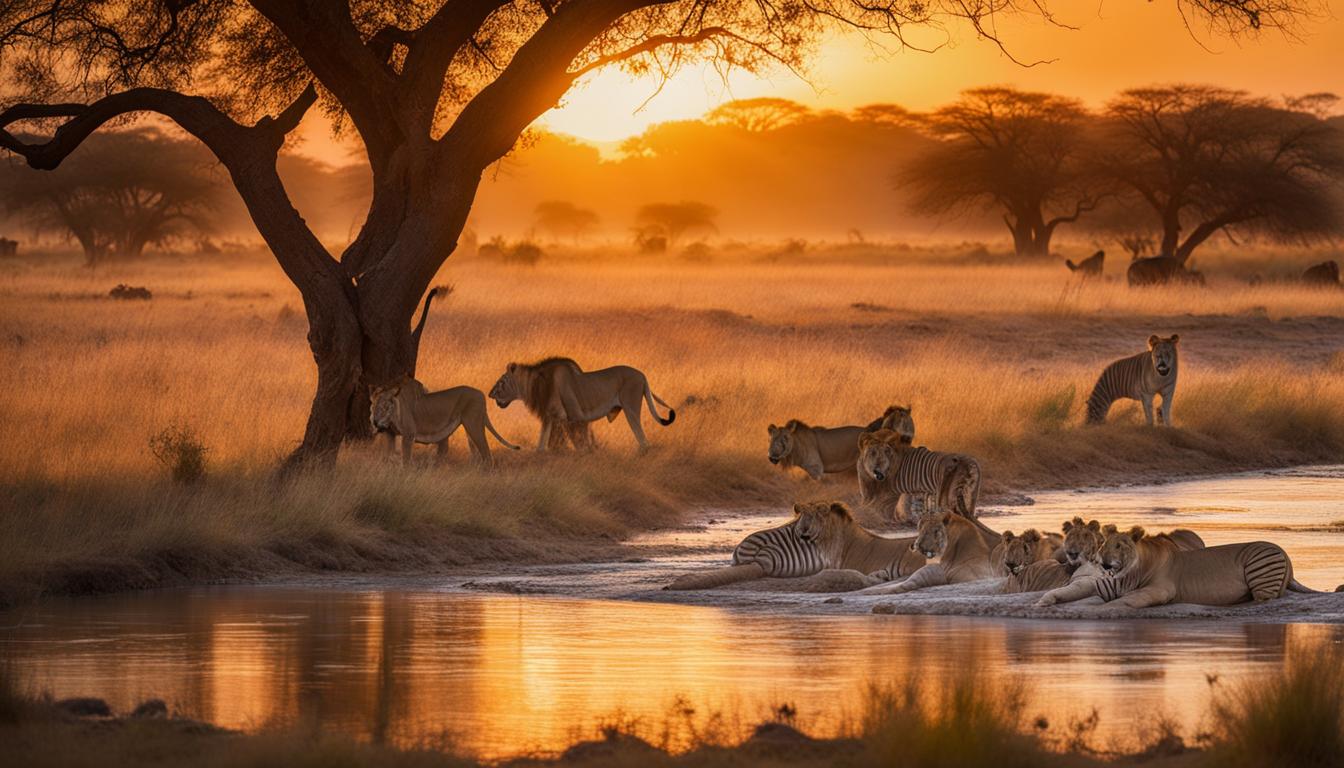Lions, as apex carnivores, have developed remarkable strategies to coexist with other predators in their habitats. From weighing the risks and rewards of interactions with species like spotted hyenas to understanding the dangers posed by humans, lions have adapted to maintain a delicate balance in their ecosystems. The study of lion coexistence is crucial for effective wildlife management and conservation efforts.
Key Takeaways:
- Lions have co-evolved with other predators and developed strategies for coexistence.
- They understand the risks posed by hunting cattle and avoid landscapes frequented by livestock.
- Understanding lion coexistence is essential for wildlife management and conservation.
- Lions prioritize hunting the largest ungulates for optimal foraging.
- Human-lion interactions, including livestock predation, are important challenges for conservation.
Lion Habitat Selection and Prey Preferences
Lions, the apex predators of their habitats, exhibit specific habitat selection patterns and prey preferences. Research conducted in the Greater Limpopo Conservation Area has shed light on the factors influencing their choices. Lions show a strong inclination towards selecting landscapes where the largest ungulates thrive. These include buffalo, zebra, and wildebeest, which provide substantial amounts of food for their efforts.
Their preference for these species aligns with the ecological theory of “optimal foraging,” where predators prioritize prey that offers the highest energy return. By focusing on the largest ungulates, lions can maximize their nutritional intake while minimizing energy expenditure.
Interestingly, lions also display a remarkable understanding of the risks associated with hunting cattle. They actively avoid landscapes used for livestock farming, recognizing the danger and potential threats posed by such encounters. This avoidance behavior may be driven by the perceived risk of retaliation from herders, indicating a level of intelligence and adaptability within the lion species.
| Prey Species | Frequency of Selection |
|---|---|
| Buffalo | High |
| Zebra | High |
| Wildebeest | High |
| Cattle | Avoided |
Implications for Lion Conservation
The habitat selection and prey preferences of lions have important implications for their conservation. By understanding the specific landscapes and prey species they rely on, conservation organizations can work towards protecting these critical resources. Safeguarding healthy populations of wild ungulates is essential for maintaining lion populations and ensuring their long-term survival.
Furthermore, mitigating lion-livestock conflicts through the implementation of lion-proof enclosures and community-based initiatives can help promote coexistence between humans and lions. By addressing the challenges associated with predation on livestock, we can alleviate tensions and foster harmony between local communities and these magnificent predators.
In conclusion, the study of lion habitat selection and prey preferences provides valuable insights into the behavior and conservation needs of these iconic carnivores. By prioritizing the protection of their preferred prey species and implementing strategies to mitigate conflicts, we can work towards a future where humans and lions can coexist in harmony, ensuring the preservation of biodiversity and the long-term survival of these majestic animals.
Understanding Human-Lion Interactions
Human-lion interactions have evolved over thousands of years, from humans being prey to becoming competitors and hunters of lions. One of the most pressing challenges for lion conservation today is the conflict between humans and lions, specifically in relation to the predation of livestock. While it is true that lions may occasionally kill cattle, they do not target them as frequently as expected. This can be attributed to the perceived risks associated with hunting cattle, such as the potential retaliation from herders.
To address the issue of lion-livestock conflict, it is essential to promote lion tolerance and implement community-based initiatives. These initiatives aim to protect both wild ungulates and livestock, ensuring coexistence between lions and human communities. Encouraging the use of lion-proof enclosures for livestock can effectively prevent lion-livestock deaths and reduce the economic losses experienced by herders.
Furthermore, fostering a sense of shared responsibility and collaboration between conservation organizations, local communities, and governments is crucial. By working together, we can develop and implement strategies that not only protect lion populations but also address the socio-economic concerns of local communities. This includes finding alternative livelihood options for communities heavily reliant on livestock farming and raising awareness about the importance of lion conservation.
Quotes:
“Lions may occasionally kill cattle, but they do not target them as frequently as expected. This is likely due to the perceived risk of hunting cattle, such as the threat of retaliation from herders.” – Lion Conservation Expert
Lion-Livestock Conflict: A Comparison
| Challenges | Lion-Livestock Conflict | Resolution |
|---|---|---|
| Loss of Livestock | High | Lion-proof enclosures, community-based initiatives |
| Retaliation and Conflict | High | Lion tolerance, shared responsibility |
| Conservation Impact | High | Collaboration, awareness, alternative livelihoods |
Lion-livestock conflict poses a significant threat to both lion populations and the livelihoods of local communities. By understanding the dynamics of human-lion interactions and implementing effective coexistence strategies, we can work towards mitigating these conflicts and ensure the long-term survival of lions in their natural habitats.
Coexistence Strategies for Lion Conservation
Conservation organizations like Panthera are implementing effective coexistence strategies to reduce lion-livestock conflict and ensure the long-term survival of these magnificent predators. One key strategy is the protection of healthy herds of wild ungulates, such as buffalo, zebra, and wildebeest, which are the preferred prey of lions. By safeguarding these prey species and their habitats, conservation efforts aim to provide lions with abundant food sources and reduce their reliance on livestock.
In addition to protecting wild ungulates, local communities are actively involved in lion conservation through the implementation of lion-proof enclosures for livestock. These enclosures serve as a physical barrier, preventing lions from accessing and preying on cattle. By safeguarding the livelihoods of the communities while also minimizing lion-livestock conflicts, these enclosures promote coexistence between humans and lions in shared landscapes.
Furthermore, anti-poaching patrols play a crucial role in lion conservation. These patrols help protect not only lions but all wildlife within their habitats. By deterring poachers and ensuring the safety of these ecosystems, anti-poaching efforts contribute to the overall sustainability of lion populations and their coexistence with other species.
The Benefits of Coexistence Strategies
The implementation of coexistence strategies for lion conservation not only benefits lions but also has wider ecological implications. By safeguarding healthy ecosystems and promoting functional landscapes, these strategies contribute to the overall stability and biodiversity of the habitat. A thriving lion population indicates the presence of a healthy ecosystem, as lions play a crucial role in maintaining the balance of predator-prey dynamics.
Moreover, by focusing on coexistence rather than exclusively targeting individual species, conservation efforts become more inclusive and cost-effective. By considering the needs of both humans and lions, these strategies foster a sense of shared responsibility and promote a harmonious relationship between wildlife and local communities.
| Coexistence Strategies for Lion Conservation | Benefits |
|---|---|
| Protection of healthy ungulate populations | Abundant food sources for lions, reduced reliance on livestock |
| Implementation of lion-proof enclosures | Minimized lion-livestock conflicts, protected livelihoods of local communities |
| Anti-poaching patrols | Protection of all wildlife, overall stability of ecosystems |
| Focus on coexistence rather than targeting individual species | Improved inclusivity, cost-effective conservation |
By adopting these coexistence strategies and fostering a collaborative approach, we can ensure the continued coexistence of lions with other species and promote effective wildlife management. This not only benefits lion conservation but also contributes to the preservation of our planet’s rich biodiversity for future generations.
Implications for Large Carnivore Coexistence
When studying the coexistence of large carnivores, such as lions and leopards, it is crucial to examine the population-level outcomes. Research conducted in various landscapes has shown that these competing species can coexist without significant impacts on each other’s populations. While lions may pose a threat to individual leopards, they do not suppress the overall population or affect their spatial and temporal dynamics. This finding highlights the importance of promoting functioning ecosystems rather than solely focusing on individual species when it comes to effective and cost-efficient conservation.
Understanding the implications for large carnivore coexistence has important conservation implications. By recognizing that intraguild competitors can coexist without population declines, conservation strategies can be tailored to protect entire ecosystems rather than targeting specific species. This approach not only ensures the survival of multiple carnivore species but also contributes to the overall health and balance of the habitat they inhabit.
It is worth noting that coexistence is not solely limited to large carnivores. Many different species within an ecosystem rely on complex interactions and relationships to thrive. Therefore, adopting conservation strategies that prioritize the preservation of biodiversity and ecosystem functionality can have far-reaching benefits. By considering the population-level outcomes of coexistence and implementing measures to protect habitats and prevent conflicts, we can strive for a sustainable future where diverse carnivore populations can thrive.
| Lions | Leopards | |
|---|---|---|
| Occupancy | Independent of leopards | Independent of lions |
| Population Density | Not influenced by leopards | Not influenced by lions |
| Impact on Spatial and Temporal Dynamics | No significant effect on leopards | No significant effect on lions |
The table above provides a concise summary of the findings regarding large carnivore coexistence. It showcases that lions and leopards can share the same habitat without causing population declines or disruptions in their respective dynamics. These insights are essential for informing conservation strategies and highlight the importance of considering the intricate relationships between species when working towards effective wildlife management and preservation.
Conclusion
The coexistence of lions with other predators and with humans in their habitat is a fascinating phenomenon that requires our attention and understanding. To ensure the long-term survival of these magnificent predators, effective wildlife management and conservation efforts are crucial.
By implementing strategies that protect both wild ungulates and livestock, we can promote sustainable coexistence. Conservation organizations, like Panthera, focus on preserving healthy herds of wild ungulates, allowing lions to select for wild prey and reducing the risk of lion-livestock conflicts.
Furthermore, community-based initiatives that promote lion tolerance and implement lion-proof enclosures for livestock play a vital role in mitigating human-lion conflicts. These measures not only protect lions but also safeguard the livelihoods of local communities.
Overall, by prioritizing lion coexistence and conservation, we can create a world where humans and lions can harmoniously thrive. Together, let’s embrace effective wildlife management practices and ensure the continued existence of these iconic predators for future generations.
Are Tigers as Social as Lions in Their Habitat?
Tigers exhibit a distinct tiger social structure interaction within their habitat. Unlike lions, they are generally solitary animals, preferring to hunt and patrol their territory alone. While they may form small social groups or pairs for breeding purposes, they do not exhibit the same level of social bonding as lions. Tigers rely on their strong sense of territoriality and marking to communicate and avoid territorial conflicts.
FAQ
How do lions coexist with other predators in their habitat?
Lions have co-evolved with other predators and have developed strategies to coexist. They weigh the risks and rewards of interactions with species like spotted hyenas and humans to ensure their survival.
How do lions select their prey and habitats?
Lions prefer to eat the largest ungulates, such as buffalo, zebra, and wildebeest, as they provide the most food for their effort. They also select landscapes where the biggest wild animals are present.
Do lions frequently hunt and kill cattle?
Lions do occasionally kill cattle, but they understand the inherent danger and risk involved. They avoid landscapes used by livestock, likely due to the threat of retaliation from herders.
What are the major challenges for lion conservation related to humans?
Human-lion conflicts, especially related to livestock predation, are major challenges for lion conservation. Promoting lion tolerance and implementing community-based initiatives can help mitigate lion-livestock conflict.
How can lion-livestock conflict be reduced?
Conservation organizations focus on protecting healthy herds of wild ungulates so that lions can select for wild prey. They also implement lion-proof enclosures for livestock and conduct anti-poaching patrols to protect all wildlife.
Can lions and other predators coexist without population decline?
Research suggests that while lions pose a threat to individual leopards, they do not suppress leopard populations or affect their dynamics. Conservation strategies should focus on promoting functioning ecosystems rather than targeting individual species.











